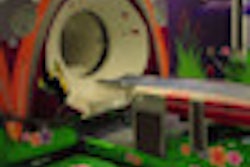CHICAGO - An analysis of more than 10 million Medicare records revealed that the risk of radiation-induced cancer from CT scans may be lower than previously estimated -- at least in the elderly, researchers reported at the RSNA 2010 meeting.
In a retrospective study using Medicare data, cancer incidence rates related to ionizing radiation were between 0.02% and 0.04%, compared with previous estimates of 1.5% to 2% in the general population, said Pat Basu, MD, a White House fellow who is on sabbatical from Stanford University in Stanford, CA.
"This is surprisingly lower than we expected," he said.
The researchers used data on patients age 65 years and older from two periods: 1998 to 2001 and 2002 to 2005. The earlier cohort comprised nearly 5.3 million individuals, and the latter comprised almost 5.6 million individuals.
They analyzed the number and types of CT scans that each patient received to determine the percentage of patients exposed to threshold radiation doses of 50 to 100 mSv (defined as low) and doses greater than 100 mSv (defined as high). They then used the Biologic Effects of Ionizing Radiation (BEIR) VII model to estimate the number of cancers that would have been caused by these examinations.
CT scans of the head were most common (25% of the first cohort and 30% of the second cohort). However, abdominal imaging -- which delivers four times more radiation than a head scan -- accounted for the greatest proportion of radiation (40%), followed by pelvic imaging and chest imaging.
The researchers found that the proportion of patients who had imaging studies increased over time. In 1998 to 2001, 42% of patients had scans, compared with 50% of those in the later cohort.
The dose also appeared to increase over time. Of patients receiving CT scans in the first cohort, 2.2% received radiation doses in the low range and 0.5% received doses in the high range. In the second cohort, 4.2% received doses in the low range, and 1.2% received doses in the high range.
Still, fewer than 6% of patients overall received doses greater than 50 mSv, Basu said.
Using the BEIR VII model, the researchers calculated that cancer incidence related to ionizing radiation was 0.02% in the 1998-2001 group and 0.04% in the 2002-2005 group.
Although only elderly people were studied, the findings could apply to middle-aged people whose biological sensitivity to radiation is similar, Basu said.
Longer-term, prospective studies are needed to understand better the advantages and disadvantages of radiation exposure from CT scans, he said.
Asked to comment on the study, William Hendee, PhD, a distinguished professor of radiology, radiation oncology, biophysics, and bioethics at the Medical College of Wisconsin in Milwaukee, urged caution in applying the findings to people of other ages.
"You would expect cancer risk to be lower in the elderly, who may die due to other reasons before a secondary cancer has time to manifest," he said.
Max Wintermark, MD, chief of neuroradiaology at the University of Virginia in Charlottesville, said he found the findings reassuring.
"There have been a number of studies recently reporting the increase in the utilization of CT scans, but to my knowledge, this is one of the first studies to look ... at the impact of these scans in terms of cancer risk," he said.
"As a radiologist, that's a question that I ask myself every day. I know we use more CT scans, and in a number of cases, it's good that we do, but I am always worried that it will be harmful to my patients," Wintermark said.
"[For] younger patients, we are always trying to do something that doesn't involve radiation. We try to use MRI or ultrasound instead, if we can," he added.
By Charlene Laino
AuntMinnie.com staff writer
December 2, 2010
Related Reading
Young women have highest cancer risk from body CT scans, July 20, 2010
High cardiac imaging doses seen in U.S. population, July 9, 2010
Young adults face higher CT radiation risk than seniors, May 4, 2010
Studies spotlight high CT radiation dose, increased cancer risk, December 14, 2009
NEJM study: Imaging procedures, radiation growing, August 26, 2009
Copyright © 2010 AuntMinnie.com



















